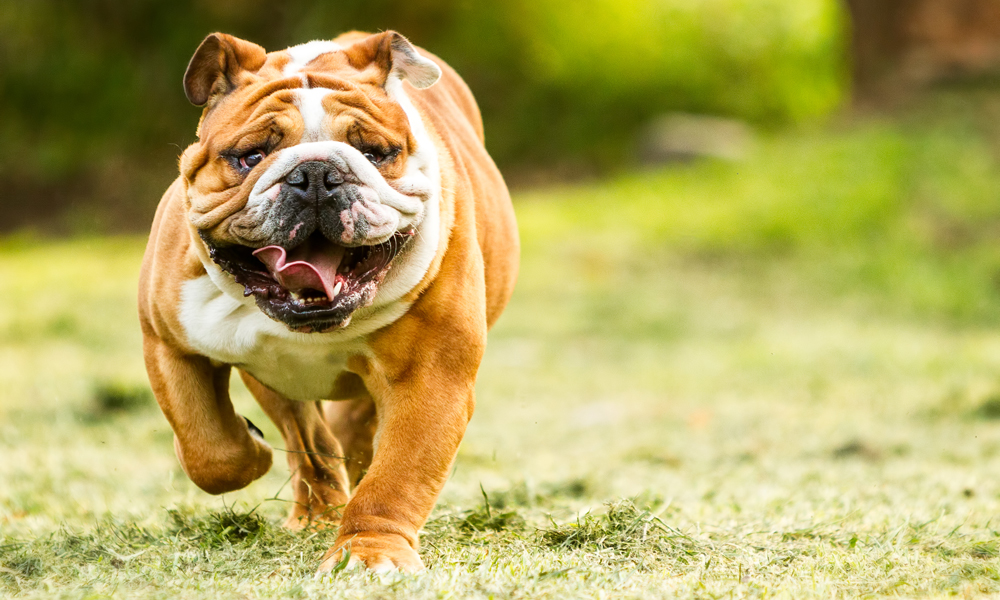The jowly, grumpy face of the bulldog makes it one of the most distinctive dogs out there. Whether a bulldog is your pet of choice, or the breed occupies a sizable slice of your mutt’s DNA pie chart, life with these dogs means having a strong, loyal companion by your side.
If a bulldog is a breed or blend you’re considering, take a look at this essential information.
Bulldogs at a glance
Appearance: With their short, pushed-in noses and hanging chops that give them that jowly look, the bulldog’s mug may give a first impression of a gruff, no-nonsense character. But really, many pet parents will say that’s what makes them so endearing.
Height: 14-15 inches
Weight: 40-50 pounds
Life expectancy: 8-10 years
Breed type: Non sporting
Fun fact: Their large heads and short legs make them poor swimmers. But with a fitted life vest, they’ll have a blast playing in the water.
Bottom line: If you’re looking for a dog who’ll love spending a quiet weekend in with you (other than a few walks to the park), barks little and is loyal to the end, this could be the dog for you.
Do bulldogs make good pets?
People who are new to the breed may have questions about what lies beneath this dog’s tough-guy exterior. Are they dangerous? Do they bite? The short answer is, like many breeds, bulldogs that get the training and socialization they need to understand what’s expected of them will be a wonderful addition to any family. To understand this breed, it can help to know their origin story, followed by a few things to know about their personalities.
Where do bulldogs come from?
Bulldogs were originally bred in England. Their wide jaws and short, stocky bodies were well-suited to helping butchers control livestock. Later, they were bred as a sporting dog in the gruesome practice of bull-baiting (which has been outlawed since 1835).
Since then, bulldogs were exported to Germany and the United States where they were enlisted to help farmers herd hogs and cattle. In fact, it was their crossbreeding of the bulldog led led to the creation of the Boxer and the American Bulldog breeds.
Meanwhile in England, the dog faced extinction with the outlaw of bullbaiting. So breeders who didn’t want to see this dog disappear forever focused on breeding out its aggressive traits, making it more suitable as a family pet.
Still, its heavyweight champ persona has stuck. It’s the mascot at dozens of U.S. universities as well as hundreds of secondary schools. To call someone a bulldog is to say they have strength and tenacity.
Taking the lead with your bulldog
As puppies, they’re known to nip at your ankles. Like many dogs, bulldogs go through a biting phase early in life. Your feet will be the favored target of this low-to-the-ground dog. With training and socialization, however, a bulldog can learn to stop biting.
When provoked, if they believe you or your family are under threat, a bulldog can become aggressive. Some bulldogs can also show food aggression, so if you have other pets or small children, it’s best to closely supervise mealtimes, and ensure the dog can eat without being disturbed.
Bulldogs, despite their easygoing personalities, can be stubborn. If they decide they do not want to do something, it can be difficult to convince that bulldog to change his mind.
Assert yourself as the leader, complete obedience training, and be ready with rewards when your bulldog is being good. Most of all, the best way to respond to unwanted behavior is to catch them in the act with a firm “no.”
Spending time with your bulldog
As dogs go, bulldogs tend to be on the mellow side. It’s rare to see this breed get a case of the zoomies when excited, and some will go as far as to say that bulldogs are lazy. Yet, the AKC doesn’t rate this dog as a couch potato, which means they actually enjoy being active, as long as you encourage it.
Work in the daily walks
While they do quite enjoy a Sunday afternoon curled by your side, walks and playtime also make them happy.
Bulldogs tend to have weight issues, though, which, in turn can cause joint pain, increase the risk of hip dysplasia and lead to breathing issues. Exercise is a must for these dogs if you want them to be healthy and fit. Take walks at least twice a day, if possible. Engage their senses by trying new parks and places.
Play games
In addition to walks, bulldogs enjoy backyard games with the family. Play hide and seek, fetch and tug of war. Though poor swimmers due to their physique, they do well with a well-fitted life vest, and may enjoy playing a few water games.
Mind the weather
Being a short-haired breed, bulldogs will need a jacket and some booties for cold weather protection. On hot summer days, be mindful of the heat and humidity. With their short noses, it’s difficult for bulldogs to cool themselves by panting, unlike other breeds. So if your bulldog seems to be struggling in the heat, take a break. Rest in the shade or head indoors to air conditioning, and offer ice chips and drinks of water before their bodies get overstressed.
Can bulldogs be left alone?
Given their mellow demeanor, you may wonder how well a bulldog does being home alone during the workday. A trained adult can handle you being out for no longer than 8-10 hours at a time. (In fact, he may spend a good chunk of the day dozing in the sun.) if you have a puppy, you’ll want to get someone to give him attention and a potty break once or twice a day. Keep his favorite toys handy, so he doesn’t get bored. Because your pup is a companion animal, make it a habit to come home on time, because they’ll be overjoyed to see you!
Keeping your bulldog happy and healthy
Bulldogs are not without their health issues (explained below). Their lifespan is brief by canine standards, at 8-10 years, and by the time they reach 5 or 6, they can start showing signs of aging.
If you’re interested in the breed and you’re planning to go the puppy route, it’s highly recommended that you look for a breeder or a rescue organization that uses best practices and abides by a code of ethics to ensure the healthiest possible pet. A good place to start is in the Bulldog Club of America’s Breeder Referral List.
To keep them healthy, establish a relationship with a veterinarian immediately, preferably one that’s knowledgeable about the breed, and bring in your bulldog for twice annual visits.
Maintaining a healthy coat
Though a short-haired breed, bulldogs do shed, but luckily, it’s not as noticeable as it may be for long-haired breeds. Twice-a-week brushings with a soft brush can keep their coat soft and in good condition.
Bulldogs are susceptible to dermatitis, a skin inflammation. When brushing your pet, check the folds on the face and body to make sure these areas stay clean and free of food, dirt and other gunk. Otherwise, trapped moisture and particles can lead to irritation. A quick cleanup with a soft washcloth or non-toxic pet wipes can keep these wrinkle folds clean and their skin in good condition. (To speed up drying after cleanup, carefully apply a bit of cornstarch afterwards.)
Maintain a healthy weight
It’s important to keep your bulldog at a healthy weight. Extra pounds can bring on early arthritis if your pet has hip dysplasia and it can also be a contributing factor in a torn knee ligament.
Eye problems
Bulldogs are prone to several types of eye issues, including dry eye, corneal ulcers and cherry eye, which is a prolapsed third eyelid that looks like an uncomfortable red bulge.
Cancer
This affliction is a common cause of death in older bulldogs, and they’re especially prone to mast cell and lymphoma tumors.
Hip dysplasia
Your pet’s health provider should retrieve an x-ray of your pet early in life to make sure their hip bones have formed properly. Without treatment, this condition can lead to painful arthritis.
A happy life with your bulldog
Millions of pet parents can’t be wrong. This breed shows up at No. 5 on the AKC’s list of most popular dogs. Maximize the years by providing your friend with a high-quality diet that builds healthy bodies from nose to tail.
At family-owned NutriSource, we formulate all our foods with our innovative Good 4 Life® system. The probiotics and prebiotics aid in mineral absorption and support immunity by the production of natural antibiotics and antifungals in the gut for optimal health. Find NutriSource at your local, independent pet retailer.


